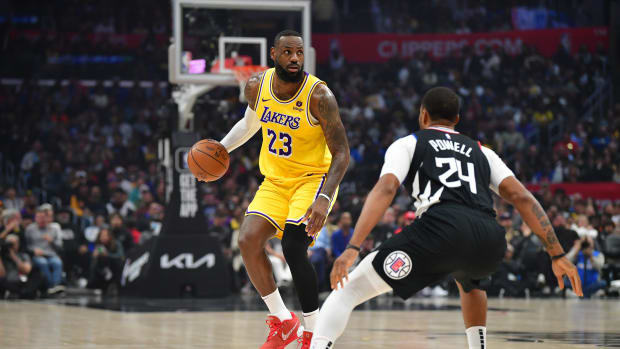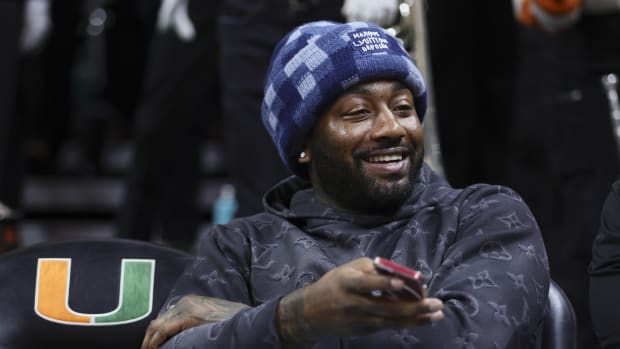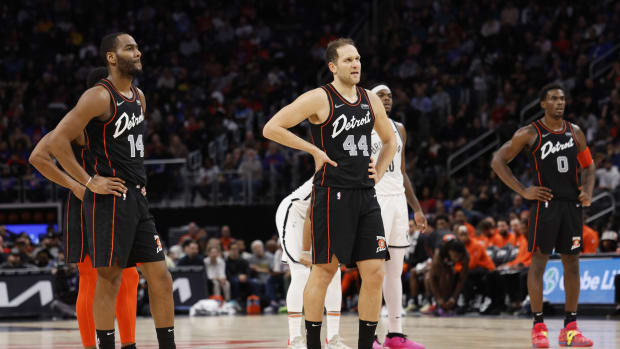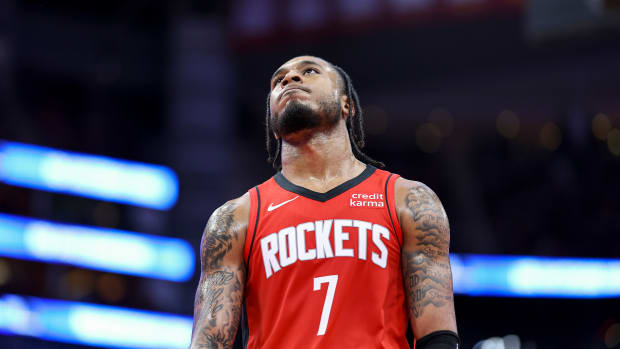2020 NBA Draft: Early Look at the Top Prospects in Next Year's Class
While the basketball world stops every March to focus on the NCAA tournament and orient itself toward the forthcoming draft, in the background, NBA teams are always looking down the road. So, I spent two days in Atlanta last week amongst a huge contingent of NBA personnel watching this year’s McDonald’s All-Americans practice in private (read: preparing for the 2020 draft). While this group is more than a year away, having some feel for the strength of the class is essential for forward-looking teams and those trying to quantify the worth of a future draft pick from an asset value perspective.
We last checked in on the state of the 2020 class in January at the HoopHall Classic. Events like the McDonald’s game, Hoop Summit and Jordan Brand Classic all offer utility in the sense that you’re throwing the best players across the country onto even footing and seeing who stands out in a gym that offers a higher base level of talent for context. Conversely, the folly of these types of evaluation settings is that, by and large, they simply don’t mean much. At this event a year ago, the gym was buzzing over Nassir Little’s explosiveness and the high-energy play we saw from Keldon Johnson. Both players continued to exhibit those positive traits as college freshmen and are expected to be one-and-done, but neither can be considered a surefire lottery pick as we move into the spring. Harping on a player’s distinct, immediate strengths in unstructured play can make it harder to weight their less-obvious flaws.
The difficulty of putting stock into these practices cuts both ways: Zion Williamson, who you’ve surely heard is the consensus top prospect as the 2019 draft nears, was unconvincing last year in the same setting. “Man, he looked horrible,” one scout recalled. It wasn’t far from the truth, either. What not everyone realized at the time was that Williamson had played an injury-shortened high school season and was nowhere near peak condition by the time McDonald’s week came around. Knowing what everyone knows now, that excuse is easier to rationalize; back then, you might have instead harped on his long-term weight concerns in a negative fashion. It turned out Williamson badly needed the summer to get into shape, and so he didn’t truly take off as a clear candidate for No. 1 until the exhibition games Duke played in Canada, which offered compelling evidence. All of this is to say that at the end of the day, anyone walking away from an All-Star setting with a fully-formed opinion of a prospect is either bad at their job or lying.
Still, in taking the pulse of the room at these sorts of things, there’s still a good deal of information that can be gathered. Not all of it is shiny and positive. So, it’s worth noting that the vast majority of NBA evaluators I spoke with on the matter came away largely unimpressed with this year’s group of seniors during a week where the energy level was very up-and-down by most accounts. There is a general level of concern that 2020 could bring a second consecutive underwhelming draft class, and what we saw at McDonald’s did little to shift that opinion. As far as 2019 is concerned, the presence of Williamson, and to a lesser extent the ascendance of Ja Morant have at least given tanking teams a bit of hope going into the draft lottery.
Unfortunately, at this stage of the process, there’s not as much salvation to be had when gazing down the road to 2020. There’s a much stronger group of international prospects on the way, and far too much time on the clock to draw serious conclusions, but it is worth noting that no player has staked a convincing claim for the No. 1 pick at this point, and that many scouts walked away from the week generally underwhelmed. We’ll hold off on trying to rank next year’s class for as long as possible, but for now, you’ll find notes and extended thoughts on the top long-term prospects in attendance below.
James Wiseman | Memphis
Height: 7’1” | Weight: 245 | Pos: C
While it would have been more or less impossible for Wiseman to shake his reputation for inconsistent effort over the course of a few days, he certainly didn’t hurt himself by showing up. He appeared to be in good physical shape, has moments where he makes basketball look somewhat unfair, and moves more fluidly than guys his size should. With as skilled as he is, Wiseman unsurprisingly suffers from what I like to call Big Guard-Itis, preferring to generate his offense far away from the basket to mixed results and often at the expense of efficient attempts. He is a clear candidate to go first overall, but there are some obstacles he’ll need to clear beforehand.
Wiseman is enormous, having measured with a 7’6” wingspan and 9’3” standing reach, and when he does play hard, the results tend to be eye-popping. He can get up and down the floor, alter shots on the move, and can create easy looks just by dint of being large and coordinated. He’s a lefty, and his jump shot has to become more consistent, but it would seem to project to three in a more legitimate way than, say, Deandre Ayton’s did. As Wiseman jockeys to be the No. 1 pick, expect some parallels to be drawn between the two bigs, noting the similar questions pertaining to their competitive motor. Wiseman is a bit more skilled at the same stage and is unusually mobile, but lacks Ayton’s absurdly freaky athleticism and body type, creating a scarier floor if things don’t pan out.
Teams will be visiting Memphis early and often come fall to see if Penny Hardaway can get the most out of Wiseman, and if he does, there’s quite a bit of potential to unlock. But noting the shifting value spectrum for NBA centers and what winning teams are asking their centers to do, he’ll require further evaluation. Wiseman’s effort level at McDonald’s was a positive, but scouts are going to want to see him dominate in college, and put all his tools to use on a consistent basis.
Anthony Edwards | Georgia
Height: 6’4” | Weight: 210 | Pos: SG
Also in the early mix at No. 1 is Edwards, although his week was somewhat up and down, and there were moments he seemed to fade into the background a little bit more than you’d like. That aspect of his game is unlikely to be a problem at Georgia next season, where you can expect him to get a healthy dose of on-ball touches as he continues to try and develop into a viable lead-guard option at the NBA level. Watching Edwards apart from the context of his high school team (which was not very well put-together, relatively speaking) was instructive, and athletically, he’s as fluid, strong and explosive as advertised. He has immense upside defensively, where he’s laterally agile on the ball, but how much he can access his playmaking potential will be the chief focus going into the fall.
It’s key to note that Edwards played as a tailback in football growing up and only picked up basketball full-time as a high school sophomore, which, given the fact he reclassified up a year, was not all that long ago. That athletic background is evident in his body type and his physical, downhill style, but also with his decision-making ability, which can at times be mechanical and currently lags a step behind some of his peers. Edwards is capable of making great passes, but doesn’t always process the floor at a high level. His development as a guard will be scouts’ primary focus this fall.
Skill-wise, Edwards’ jumper is the primary thing to watch. He likes to take off-balance shots and looks more comfortable shooting off the dribble, but consistency might be an issue in the short term. After a pair of poor shooting performances in practice, he did hit a few from distance in the scrimmage, and when it does go down, it looks impressive. Edwards doesn’t need a ton of space to get his jumper off, and it comes out with consistent rotation more often than not. If he continues making all-around strides, he will be in the mix at No. 1, but again, a lot of what we’re discussing with him right now involves heavy projection.
Jaden McDaniels | Uncommitted
Height: 6’11” | Weight: 195 | Pos: PF
In terms of pure talent, McDaniels might be the most intriguing player in this class, but he’s still a ways away from being a finished product and is a tricky guy to project right now. He did not have the best week, and blended in a little bit on a team where Edwards, Scottie Lewis and Cole Anthony dominated the ball. McDaniels is an unusually fluid, tall forward who can do guard-like things at his size, shoot over defenders, and has a demonstrable feel for passing and defending, as well. His ability to get to his jumper cleanly off the dribble at his height is rare, and in the best-case scenario, he could become an extremely difficult player to defend. He’s been gifted with great coordination and fluidity that can’t be undersold, and can contribute defensively as well with his agility and a decent level of toughness for a guy built as thinly as he is. McDaniels is in the mix at No. 1 from a talent standpoint, but has a lot of work to do at this juncture.
However, there’s fear among scouts that McDaniels’ body type may prove a legit impediment when projecting forward. He’s not remarkably explosive and is rail-thin, which can make it difficult for him to actually use his mismatch. If he can’t bang consistently inside with bigs, and if stronger wings can successfully slow him down, it’s a little tricky to see all of his offense translating. When you look at his older brother Jalen, who is similarly built and a projected 2019 draftee with pronounced strengths and weaknesses, it’s easy to envision Jaden having some of the same pitfalls, particularly if he’s not being used creatively on offense. He does have terrific touch, and if he expands his off-dribble game and ends up something like a power forward version of Brandon Ingram, it wouldn’t be a bad outcome at all. His upside could certainly be higher than that.
The fact McDaniels is a bit of an introverted personality on the floor and didn’t have a great week shooting the ball made it a bit tricky for him to set himself apart in this environment. His senior year on whole has been slightly underwhelming in the minds of some who know the high school circuit well. Washington (the hometown option) and Kentucky are thought to be the two finalists, but he’s kept largely mum about everything. Where he ends up will be a key storyline going into the fall.
Isaiah Stewart | Washington
Height: 6’9” | Weight: 245 | Pos: C
To Stewart’s complete credit, he is not someone his peers appear to enjoy playing against: he gives his all in every setting, no matter how competitive the structure, and won’t ever have to be reminded to rebound and take care of small things inside. At least one scout I spoke last week with made a case that Stewart had been the best player (though not necessarily prospect) at the entire event. He consistently wins 50-50 balls with effort, stays active with his feet and length (a 7’4” wingspan and 9’0” standing reach will be huge for him), and is a vocal defensive quarterback who will be an ideal fit at Washington.
Stewart is not a elite upside guy—he isn’t a consistent shot-creator and may get nitpicked as a rim protector within the zone—but his intangibles point to an extremely high floor as a future NBA rotation piece. The way he’s remade his body and added to his offensive skill set over the past two years has been noteworthy, and it doesn’t take long at all for him to win you over. If Stewart can add a pick-and-pop element to his game as a screener and remain efficient using second-chance opportunities next season, he should be someone teams feel extremely comfortable with in a year’s time. He’ll rebound at a high level, he’ll defend, and he’ll give maximum effort.
Cole Anthony | Uncommitted
Height: 6’3” | Weight: 185 | Pos: PG
Anthony’s case will be interesting to parse going forward, as he will be directly vying for draft position against highly-rated French point guard prospects Theo Maledon and Killian Hayes. The son of former NBA guard Greg Anthony is the top American point guard right now, and appears to do enough thing at a high level to project with a degree of comfort into an NBA role. He seemed more focused on making plays off the dribble than scoring this week, which was positive given that he can be trigger-happy at times despite being just an average jump shooter. Right now, it’s fairly easy to slot him into next year’s lottery, although where exactly he falls will be fluid.
There’s some debate among scouts right now as to where Anthony’s ceiling might be, but he does have a reasonably good set of skills already that profile as a potential starting-caliber player. He’s quick and an explosive leaper, but is not physically imposing and appears to be a bit smaller than his listed height, which are where some of the questions stem from. The shooting concerns come with some foundation, although he’s far from a zero beyond the arc. Continuing to show he can be effective running a team will help Anthony’s case. He’s a vocal, intense competitor and should be impactful from day one wherever he commits, with North Carolina looking like a strong option given Coby White is likely bound for the NBA, and Oregon in the mix, among others.
Scottie Lewis | Florida
Height: 6’5” | Weight: 185 | Pos: G/F
Lewis has continued to solidify his stock in NBA circles, with a high-intensity approach to the game that almost always serves him well. From an intangibles perspective, he should have a clear path to a career in the league. While at times his emotions can dictate the quality of his play, and he does have moments where he tries to do too much on offense, Lewis pairs his intelligence and plus on-court communication skills with strong physical tools on the wing. There’s an obvious floor with him and the way he approaches defense, and his body should be able to fill out a bit more, as well. As Lewis’s offensive skill set continues to catch up to the rest of his game, he should have a case in the 2020 lottery based on his trajectory.
The long-term question is where Lewis’s ceiling ends up. He’s a high-flyer, fast with the ball and solid in transition, if not always entirely under control. An explosive first step helps him slash to the rim and into the paint, and he has continued to put in evident work on his jump shooting. It’s obvious from an observational perspective that he’s more of a self-made shooter – his ball doesn’t always get great rotation and goes up with almost too much arc at times—but he has made the right type of strides over the past couple years that you can at least project him as an average threat from NBA range. If Lewis can do that, there will be a role for him in the league. It’ll be interesting to gauge where he’s at when November rolls around.




































